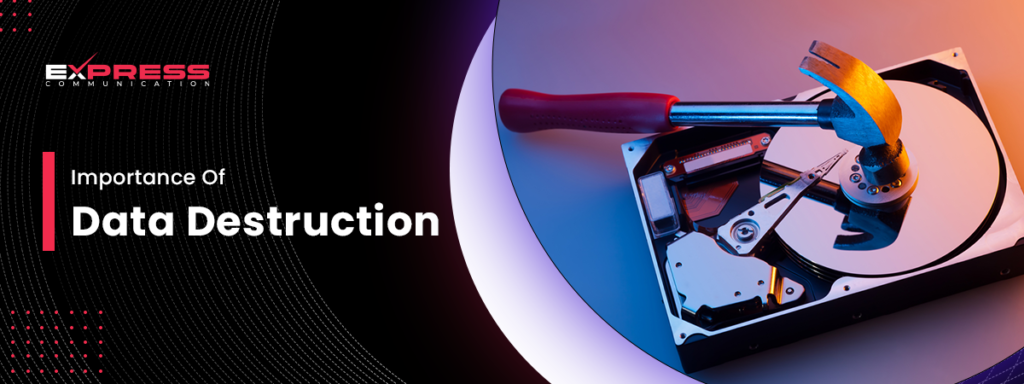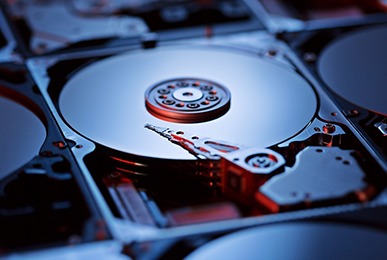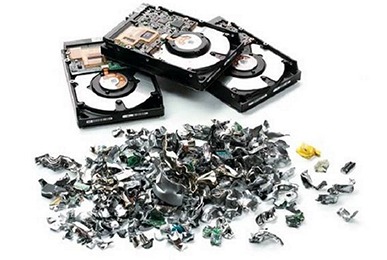
In our digital age, where data is as valuable as gold, the importance of data destruction cannot be overstated. But what exactly is data destruction? Simply put, it involves completely erasing or destroying data from storage devices, ensuring that it cannot be recovered or accessed by unauthorized individuals. This practice is crucial for protecting personal privacy and securing confidential information in both personal and professional contexts. In this blog, we will explore the various aspects and significance of data destruction.

Table of Contents
Why is Data Destruction Necessary?
Protecting Personal Information
Every day, we share and store personal information on various devices, from smartphones to laptops. This information can include everything from our names and addresses to more sensitive data like bank details and personal photographs. Without proper data destruction, this information could fall into the wrong hands, leading to identity theft, financial loss, and personal embarrassment.
Safeguarding Business Data
Businesses of all sizes accumulate a significant amount of confidential data related to their operations, employees, and customers. Ensuring the complete destruction of this data when it is no longer needed is essential to prevent corporate espionage, legal issues, and breaches of trust.
Compliance with Legal Requirements
Many countries have strict regulations requiring the proper disposal of data. For instance, laws like the General Data Protection Regulation (GDPR) in the European Union enforce stringent measures to ensure that personal data is securely destroyed to protect individual privacy. Non-compliance can result in hefty fines and reputational damage.
How Does Data Destruction Work?
Physical Destruction
Physical destruction involves destroying the physical device holding the data, making it impossible to retrieve the data. This can be done using various methods:
- Shredding: Devices like hard drives are physically shredded into small pieces.
- Degaussing: This method uses a high-powered magnet to disrupt the magnetic fields in storage devices, thereby erasing the data.
- Incineration: Devices are completely burned to ash.
Digital Destruction
Also known as data wiping or software-based destruction, this method uses specialized software to overwrite existing data with random data, multiple times. This ensures that the original data is completely overwritten and irrecoverable.
Methods of Data Destruction
Each method of data destruction has its own set of pros and cons, and the choice of method often depends on the sensitivity of the data and the resources available. Here’s a look at some common methods:
Shredding
Shredding is one of the most foolproof methods of destroying physical copies of data. It’s quick, effective, and ensures data is irretrievably destroyed. However, it requires physical access to the data and can be costly for large volumes of data.
Degaussing
Degaussing is effective for magnetic storage devices like hard drives and tapes. It is relatively fast and can be done on-site, but it does not work on solid-state drives (SSDs) and can be expensive.
Incineration
Incineration is a drastic method that is used for the most sensitive data. While extremely effective, it is not environmentally friendly and requires specific facilities that adhere to environmental protection standards.
Software-Based Destruction
This method is highly versatile and can be applied remotely, making it ideal for organizations that need to destroy data across multiple locations. However, it is less secure than physical methods, as the process can sometimes leave traces that can be recovered with advanced tools.
Choosing the Right Data Destruction Method
When it comes to selecting a method for data destruction, several factors need to be considered to ensure the choice is appropriate for the specific needs of the individual or organization. Here’s a guide to help make that decision:
Assessing the Type of Data
The first step is to consider the type of data you need to destroy. Is it highly confidential corporate data, personal information, or less sensitive general business data? The level of sensitivity can often dictate the method of destruction required to ensure that the data is irreversibly destroyed.
Volume of Data
The amount of data to be destroyed also plays a crucial role in determining the method. Physical destruction methods like shredding and degaussing are more suitable for large volumes of physical storage devices, whereas software-based destruction might be more feasible for smaller amounts or for data spread across various locations.
Cost Considerations
Cost is always a significant factor. Physical destruction methods can be costly, especially for large volumes of data, whereas software-based destruction might offer a more cost-effective solution. It’s important to balance the budget with the necessity of thorough data destruction.
Environmental Impact
The environmental impact of data destruction methods should also be considered. Methods like incineration have a high environmental impact compared to others like software-based destruction or even shredding. Organizations increasingly consider their environmental responsibilities when choosing a destruction method.
Benefits of Proper Data Destruction
Understanding the benefits of proper data destruction can highlight its importance even further:
Prevents Data Breaches
One of the primary benefits of effective data destruction is the prevention of data breaches. By ensuring that sensitive data is completely destroyed, you significantly reduce the risk of this data being accessed by unauthorized parties and potentially used in malicious ways.
Maintains Privacy
For individuals, proper data destruction is essential for maintaining privacy. In a world where personal information can be a key to identity theft, ensuring that your data is completely destroyed when it’s no longer needed helps keep your private life private.
Protects Intellectual Property
For businesses, destroying data securely protects intellectual property and business secrets that could be devastating if they fell into the wrong hands. This is crucial for maintaining a competitive edge in the market.
Ensures Legal Compliance
Many industries are governed by legal requirements that mandate the secure destruction of data. Proper data destruction ensures compliance with these laws and can prevent costly fines and legal battles.
Challenges of Data Destruction
Despite its importance, data destruction is not without its challenges:
Ensuring Complete Destruction
One of the biggest challenges is ensuring that the data is completely destroyed. With the advancement of technology, even data that seems irrecoverable can sometimes be restored using sophisticated techniques.
Managing Multiple Devices and Formats
In today’s multi-device world, data is not stored in a single format or location. Ensuring that all data across all devices and formats is destroyed can be a complex logistical challenge.
Keeping Up with Technology
Technology is always evolving, and methods of data storage are constantly changing. This means methods of data destruction must also evolve to effectively handle new types of storage media.
Cost and Resource Allocation
Effective data destruction can be resource-intensive and costly, especially for large organizations or those that handle a significant amount of sensitive data. Allocating the necessary resources without impacting other business operations can be a challenge.

Overcoming Challenges in Data Destruction
To navigate the complexities and challenges associated with data destruction, organizations and individuals can adopt several strategies:
Regular Policy Review and Update
Regularly reviewing and updating data destruction policies ensures that practices remain in line with current technological advancements and regulatory requirements. This proactive approach helps in adapting to new data storage trends and destruction technologies.
Employee Training and Awareness
Educating employees about the importance of data destruction and how to properly handle and dispose of data is crucial. Regular training sessions can help prevent accidental data breaches and ensure that all team members understand their roles in the data destruction process.
Utilizing Professional Services
For many organizations, especially those without the necessary equipment or expertise, outsourcing data destruction to professionals is a viable option. Professional data destruction services have the tools and knowledge to securely destroy data, providing peace of mind that all data is handled correctly.
Implementing Secure Erasure Software
For digital data, secure erasure software is an effective tool. This software is designed to completely overwrite data, making recovery impossible. Using trusted and recognized software solutions ensures compliance with international standards for data erasure.
The Future of Data Destruction
As technology evolves, so too do the methods for data destruction. Here are some emerging trends that are shaping the future of this critical field:
Advanced Shredding Technologies
Innovations in shredding technology continue to improve the efficiency and effectiveness of physical destruction. Newer machines can handle a wider variety of materials and data storage devices, ensuring thorough destruction.
Enhanced Degaussing Techniques
As magnetic storage devices become more resilient, degaussing technology is advancing to provide stronger and more focused magnetic fields to ensure the complete erasure of data.
Blockchain for Data Destruction Verification
Blockchain technology could revolutionize how we track and verify data destruction. By creating an immutable record of when and how data was destroyed, organizations can provide transparent proof of compliance and security.
Automation and AI in Data Destruction
Artificial intelligence and automation are being explored for their potential to streamline the data destruction process. These technologies can help in identifying which data needs to be destroyed and executing the destruction process with minimal human intervention.
Conclusion: Ensuring Data Security Through Effective Destruction
In our increasingly digital world, data destruction plays a vital role in protecting privacy, securing intellectual property, and maintaining trust. Whether through physical destruction, digital wiping, or a combination of methods, it is imperative that all data is handled with care until it is completely destroyed. By staying informed about the latest in data destruction technologies and practices, individuals and organizations can ensure they are taking the necessary steps to protect themselves and their stakeholders.




